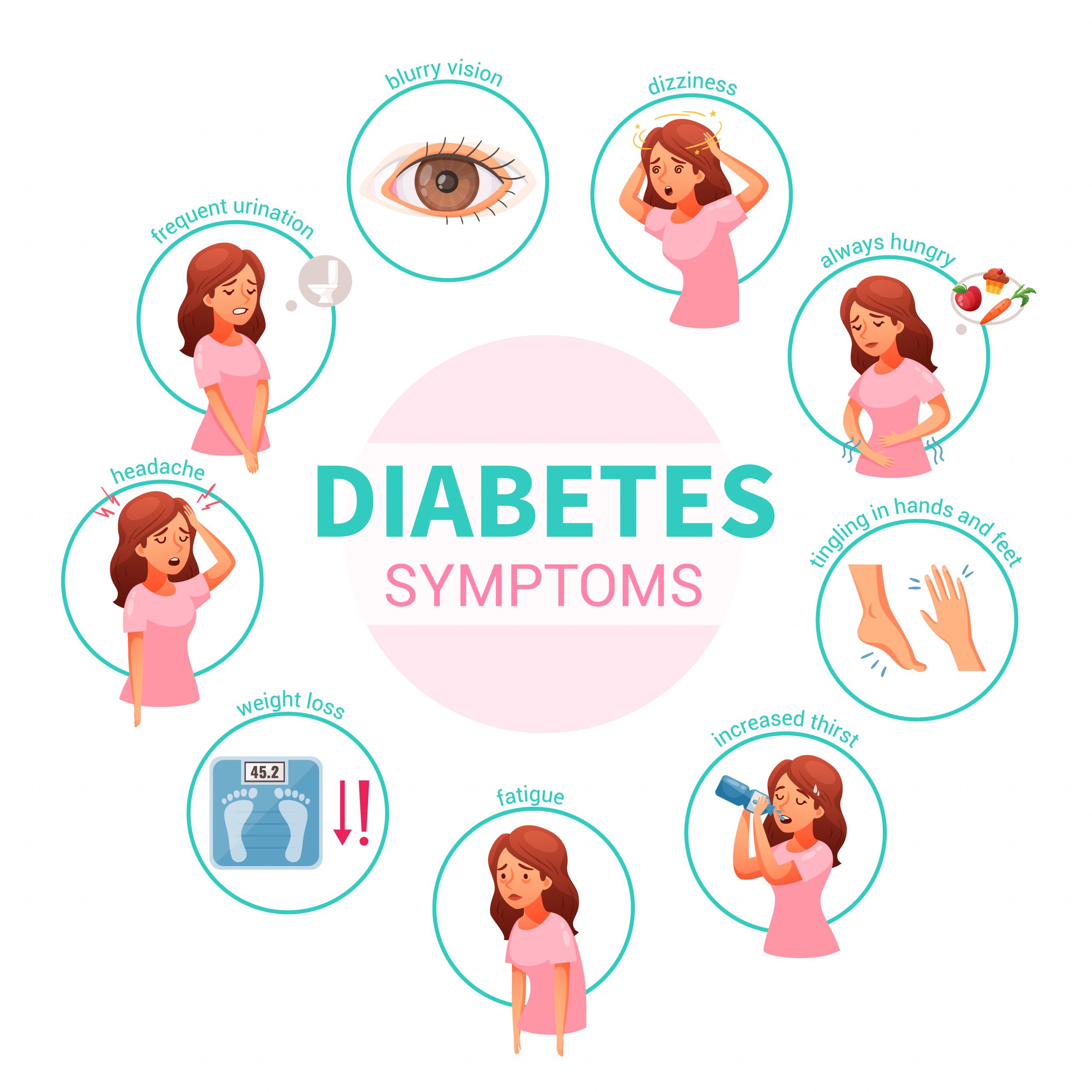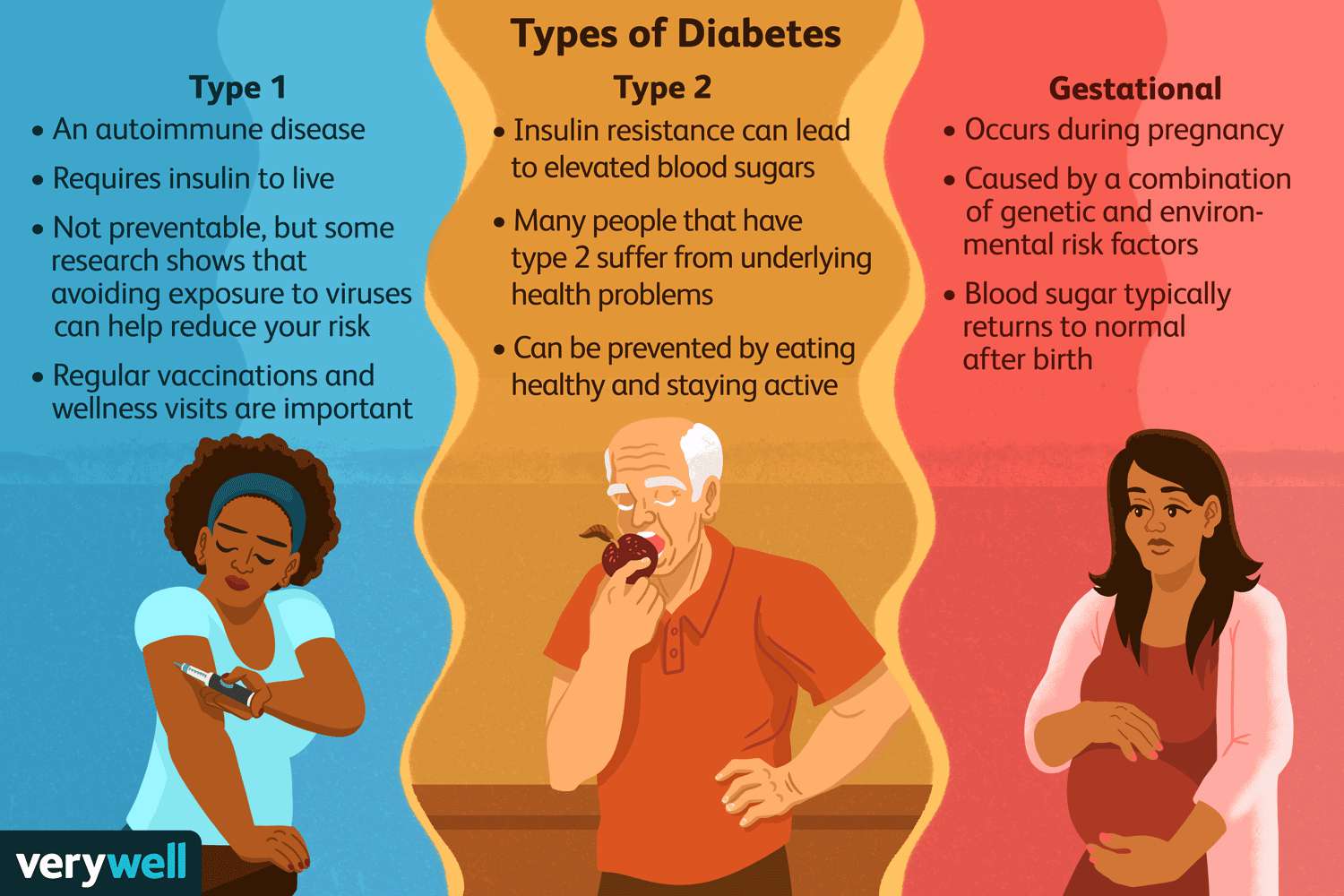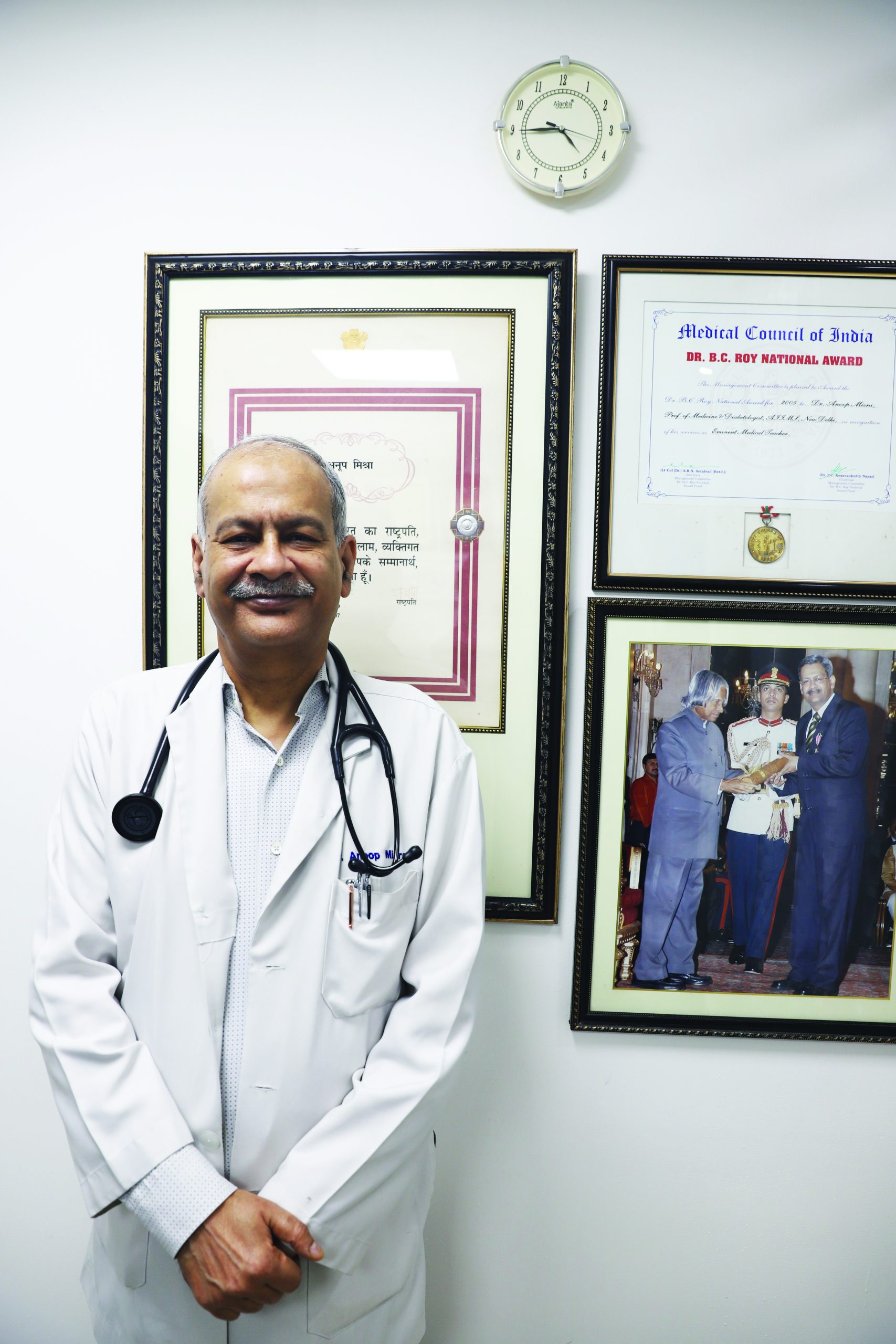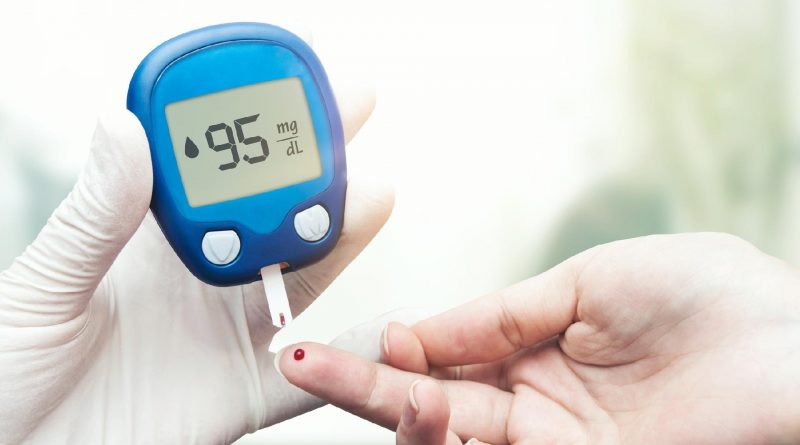Mother of All Maladies
Diabetes is emerging as one of the most common and challenging health problems of the 21st century. Rapidly increasing and reaching epidemic proportions, the disease causes substantial morbidity and mortality affecting even the youth. It has become a major public health issue, causing tremendous burden both in social and economic terms…….
By Amresh K Tiwary
Diabetes mellitus is a disease in which the body’s ability to produce or respond to insulin is impaired.Insulin is a hormone that is needed to convert sugar, starches and other food into glucose or energy needed for daily life. Diabetes results in abnormal metabolism of carbohydrates and elevated levels of glucose in the blood.
The cause of diabetes continues to be a mystery, although both genetics and environmental factors such as obesity and lack of exercise appear to play roles.
The increased thirst and urination, increased hunger, fatigue, blurred vision, numbness or tingling in the feet or hands, sores that do not heal and unexplained weight loss are common symptoms of diabetes.

Knowing causes of diabetes can help a person understand how best to treat their symptoms, and help them understand how they got diabetes in the first place. While many causes of diabetes can be prevented, some causes are just the way the body is made, and the sooner a diabetes type can be diagnosed, the sooner a person can get back to normal health and take the measures needed to take care of oneself successfully.
Diabetes is a group of metabolic disorders characterized by hyperglycaemia resulting from defects in insulin secretion, insulin action or both. Chronic hyperglycaemia is associated with long term
Damage, dysfunction and failure of various organs, especially the kidneys, eyes, nerves, heart and blood vessels.
Several pathogenic processes are involved in the development of diabetes. These range from autoimmune destruction of the beta cells of the pancreas with consequent insulin deficiencies to abnormalities that result in resistance to insulin action.
 Types of Diabetes
Types of Diabetes
Symptoms of type-I diabetes can start quickly in a matter of weeks. Symptoms of type-II diabetes often develop slowly over the course of several years—and can be so mild that you might not even notice them. Many people with type-II diabetes have no symptoms. Some people do not find out they have the disease until they have diabetes-related health problems, such as blurred vision or heart trouble.
Type-I diabetes:
Type-I diabetes is a result of the progressive destruction of beta cells which lead to severe insulin deficiency. Although the symptoms have a relatively sudden onset, the underlying pathological changes occur over a prolonged period. Beta cells destruction appears to be an autoimmune process triggered by a variety of environmental factors along with genetic susceptibility which activates this autoimmune process.
Type-II diabetes: Type-II diabetes, the most common form of diabetes, is caused by several factors, including life style and genes. You are more likely to develop type-II diabetes if you are not physically active and are overweight or obese. Extra weight sometimes causes insulin resistance and is common in people with type-II diabetes.
Type-II diabetes usually begins with insulin resistance, a condition in which muscle, liver, and fat cells do not use insulin well. As a result, your body needs more insulin to help glucose enter cells. At first, the pancreas makes more insulin to keep up with the added demand. Over time, the pancreas can’t make enough insulin, and blood glucose levels rise.
The etiology of type 2 diabetes is not established. The principle underlying defects are reduced insulin sensitivity and impaired betacell function. Together these defects initiate a sequence of events that ultimately leads to widespread metabolic imbalance and clinical diseases. Type-II diabetes begins insidiously and progresses slowly.
Apart from type-1 and type-II diabetes, there is 3rd type of diabetes called 1.5 (one point five) type diabetes described as latent auto immune disease called Latent Autoimmune Diabetes of Adulthood (LADA), which has a slower course of onset than type 1 diabetes diagnosed in juveniles.
According to Prof. (Dr.) Anoop Misra, Executive Chairman, Fortis C-DOC Hospital for Diabetes and Allied Sciences, New Delhi, the Diabetes was recognized as ancient time, and even finds reference in the Indian ancient treatise, Vedas, more than 4,500 years ago. The term “Diabetes” originated from the Greek word for ‘Siphon’, because of marked urination in patients. The term “mellitus” is derived from a Greek word, meaning ‘sweet’, in context of presence of sugar in the urine.
More than 65 million people in India suffer from diabetes, and nearly 8 percent of population above 18 years has diabetes. This figure is expected to rise in 100 million by year 2030, second only to China. Every fifth diabetes patient in the world is an Indian. A study showed that 37 percent of Delhi population suffers from diabetes or pre-diabetes. Indian have a predisposition to diabetes and nearly 75 percent of patients with type 2 diabetes have a first degree family history of diabetes.
About 90 percent patients of type 2 diabetes are either overweight or obese which is increasing in Indians. More than 60 percent women living in urban cities of India are overweight or obese. Women are at equal or sometimes higher risk for developing pre-diabetes, diabetes and diabetic related complications than man. Overall, an estimated one-third of school children are overweight or obese and 40-50 percent of school children in most metropolitan cities are overweight or obese. Diabetes –related complications are more common among Indians as compared to with other populations.
About one fifth patients of diabetes develop retinal disorders leading to vision loss. More than 50 percent of long term diabetes was affected by diabetic neuropathy leading to sensory loss, non-healing foot ulcers and impotence among men. India tops in maximum leg amputations due to diabetic foot in the world. About 20-30 percent patients of diabetic neuropathy need dialysis or kidney transplant to survive. Diabetes and hypertension are the most common cause of kidney failure in India. Silent heart attacks are high in diabetes. Heart disease in diabetic patients is more complicated, and leads to more death.
Similarly strokes are also common in diabetic patients. The highest number of deaths in India occurs due to diabetes related heart disease, more than HIV/AIDS, malaria and tuberculosis combined. \Every ten seconds, one person dies from diabetes-related cause in India. Net losses in India’s national income from diabetes and cardiovascular disease have been $ 336.6 billion between 2005 to 2015.

Why Indians are more prone to Diabetes?
Prof. (Dr.) Anoop Misra, Executive Chairman, Fortis C-DOC Hospital for Diabetes and Allied Sciences, New Delhi, says that this has been found that Indians are more prone to ‘Syndrome X’ ( a clustering of increased abdominal girth, high blood pressure, high blood sugar and deranged blood lipids), the first steps towards diabetes. Undoubtedly, Indians are more prone to excess body fat from birth. They have more clustered fat in their bodies (as much as 1.5 times more than white people from birth onwards. Most Indian children are born small, underweight and have a higher blood pressure and adiposity which increases the chance of them developing into diabetic adults at a later stage in their lives.”
Resistance to action of hormone insulin: A combination of genetic factors and excess of fat over body, abdomen and liver lends in inherent tendency for insulin to act slowly and in a way that is only partially effective.
Fatty Liver (Fat accumulation in liver, not due to alcohol): Liver is a site of excessive fat deposition that leads to sluggish metabolism in Indians. This leads to overproduction of sugar, especially during night. Such fat laden livers may also become dysfunctional and cirrhotic, and may even turn cancerous.
Fatty Pancreas (Fat accumulation in pancreas): Studies have shown that though a person may not be fat, pancreas accumulates fat easily, and which may cause dysfunction of insulin producing cells.
Sudden switch to a lifestyle that is alien to traditional Indian ways to life: Switching to more modern lifestyle is aggravating problem and driving Indians even closer to diabetes. Most people today believe in eating ready-to eat stuff and leading a sedentary lifestyle. Such habits are far from the traditional frugal Indian way of life and rapidly increase the risk of diabetes.
Genetic Factor: A number 0of genes have been identified in Indians which could predispose the race more to diabetes as compared to other races. In addition, there could be genetic tendency to accumulate excess body fat, abdominal fat and have large for cells which decrease the action of insulin. For example, experts have identified a gene ‘Myostatin’ which may cause excess of fat and low muscle mass in Indians. There are other genes which may combine with each other or with bad diet or inactivity to produces diabetes.
Treatment of diabetes
Until 1990, sulfonylureas (glyburide glipizide etc) and biguanides (metformin) drugs were available in addition to insulin.Sulfonylureas at one time was expected to cause heart problems and during that period, metformin became more popular.
Recently in last decades gliptines (DPP4 inhibitions) are on the fore front. It is still a mystery whether these drugs replace Metformin or Sulfonylureas.Metformin is a widely prescribed drug for treating type-IIdiabetes. Metformin is often the first medication that will be prescribed to people with type-II diabetes.
Metformin helps to lower blood glucose levels by reducing the amount of glucose produced and released by the liver, and by increasing insulin sensitivity. Infact sulfonylureas and its relation with cardiovascular disease in addition to a great Framingham study of 1980 opened a new era in diabetes, that is, cardiovascular metabolic diabetes.
Due to diabetes, there is wasting of muscles and patients feel weakness.Insulin has been the major focus in treatment of type-I diabetes. However, it is very common that in type-II diabetes whereas 70 to 80 percent diabetic population has a normal to high insulin level but insulin injections are given to these patients and it is still a major mystery.
Humulin (Recombinant DNA insulin), a man-made insulin used to control high blood sugar in adults, is known to reduce high blood sugar (glucose) levels in patients with diabetes mellitus. Human insulin was expected to do miracles in the treatment of diabetes.Experiment study in animals proved that insulin can prevent every cardiovascular change but it is still a mystery as to why diabetics continue to suffer from cardiovascular disease.
 According to Prof (Dr) Ramesh K Goyal, Vice Chancellor, Delhi Pharmaceutical Sciences & Research University, Delhi, the Diabetes is a common problem in older adults. Approximately 20% of individuals over 65 years of age have diabetes mellitus, and almost half of these individuals have not been diagnosed. Unlike younger people with type 2 diabetes, who are often overweight, obesity is not that common among older diabetes patients.
According to Prof (Dr) Ramesh K Goyal, Vice Chancellor, Delhi Pharmaceutical Sciences & Research University, Delhi, the Diabetes is a common problem in older adults. Approximately 20% of individuals over 65 years of age have diabetes mellitus, and almost half of these individuals have not been diagnosed. Unlike younger people with type 2 diabetes, who are often overweight, obesity is not that common among older diabetes patients.
However, there are widespread misconceptions about possible consequences of uncontrolled hyperglycemia,
In nursing homes, the problem of being underweight is as common as that of being overweight. Thus, nutritional management should focus on weight gain for underweight elderly patients as much as it is focused on weight loss for obese patients.
In addition to diet and exercise, pharmacological therapy is often required for optimizing blood glucose control. Target blood glucose ranges should be individualized. In frail patients, fasting plasma glucose levels should range from 100 to 140 mg/dl, and postprandial values should be <200 mg/dl.
The discovery of several classes of oral ant diabetic agents has increased the prospects of achieving better control of hyperglycemia with reduced risk of severe adverse events.
Some of these agents, such as acarbose, miglitol, metformin, and troglitazone, do not cause hypoglycemia when used as monotherapy. As such, they are safer agents. Metformin appears to be especially useful in obese insulin-resistant patients. The available data on safety and efficacy of troglitazone in the elderly is insufficient. The use of a combination of two or three oral anti diabetic agents to delay the need for insulin therapy is now possible. The long-term effects of this approach are not known, and the cost of polypharmacy is of concern.
The Ayurvedic view
 Dr Tanuja Nesari, Dikrector, All India Ayurved Institute, New Delhi, in Ayurveda, diabetes is known as Madhumeha (Madhu means ‘honey’ and Meha means ‘urine’). Madhumeha is categorized as VatajMeha (a problem caused by aggravation of Vata). Vata symbolizes wind and dryness. Deterioration of the body is a characteristic that indicates impairment of Vata. Maximum deterioration of dhatus (body tissues) occurs in this type of disease and this is the reason why all vital organs are affected by diabetes.
Dr Tanuja Nesari, Dikrector, All India Ayurved Institute, New Delhi, in Ayurveda, diabetes is known as Madhumeha (Madhu means ‘honey’ and Meha means ‘urine’). Madhumeha is categorized as VatajMeha (a problem caused by aggravation of Vata). Vata symbolizes wind and dryness. Deterioration of the body is a characteristic that indicates impairment of Vata. Maximum deterioration of dhatus (body tissues) occurs in this type of disease and this is the reason why all vital organs are affected by diabetes.
The other prime cause of diabetes is impaired digestion. Impaired digestion leads to accumulation of specific digestive impurities (known as ama) which accumulate in the pancreatic cells and impair the production of insulin.
According to Ayurveda, sugar levels can be kept under control with the help of proper medication and a strict diet-lifestyle plan. Because diabetes is a chronic metabolic disorder that arises when the pancreas does not produce enough insulin, or when the body cannot effectively use the insulin it produces, it can only be treated if the body is rejuvenated in its entirety.
Therefore, the treatment of diabetes recommended in Ayurveda – as against modern medicine – is aimed at rejuvenating the body to not only balance sugar levels, but also foster a positive change in the patient’s life. Ayurvedic medicines work on the root cause of the disease, strengthening the patient’s immunity, enhancing digestion and helping him lead an overall healthy life. Along with medication, dietary and lifestyle changes are also recommended to rejuvenate the body’s cells and tissues, allowing them to produce insulin properly.
Daily routine for a diabetic
Wake up time: Wake up by 6 am in the morning, as you also need ample time to exercise. Have a glass of lukewarm water mixed with two teaspoonful of fresh lemon juice every day.
Exercise: Exercise forms an important part of treatment for diabetic patients. A morning walk is the best form of exercise. Yoga and meditation can also be beneficial, especially to relieve stress and bring clarity to the mind. If your health permits, opt for exercises such as jogging, swimming, cycling, etc.
Breakfast: In the morning, take two slices of whole meal bread with butter and fresh milk (boiled and taken warm). Seasonal fresh fruits can be taken occasionally, with or without milk.
At work: If you are an office-goer, make sure you carry filling snacks with you all the time, as diabetics are advised not to keep their stomachs empty. Instead of snacking on cheese, chips or
crackers, enjoy a handful of nuts or seeds. Go for variety with sunflower, pumpkin seeds, almonds, cashews, and walnuts.
Lunch: For lunch, opt for steamed or lightly cooked green vegetables such as cauliflower, cabbage, tomatoes, spinach, turnip, asparagus and mushrooms. Vegetable soup or boiled vegetables can also be taken. In addition, two or three whole wheat bread (chappatis), sprouts, salad, boiled rice, lentils (daal) etc. can be taken according to appetite. A glass of butter milk (salty lassi) is a nice drink to end the lunch. Roasted cumin seeds, black salt, grated ginger and green coriander leaves can be added to the butter milk.
Day time sleep: If you are a non-working diabetic, always remember not to sleep during the daytime, as it increases KledakaKapha. A sub-dosha of Kapha, KledakaKapha governs the protective mucous lining of the digestive system, thereby facilitating proper digestion. In an increased state, it can lead to impairment of digestion, which can cause additional problems in diabetes patients.
Evening snacks: Have a glass of fresh fruit or vegetable juice. You can also take Ayurvedic tea with roasted chickpeas.
Dinner: Always remember that your dinner should be light and not have too many items. Boiled vegetables, sprouts, cottage cheese (paneer) or a bowl of salad made from fresh raw vegetables of the season. Also, make it a point to eat at least two hours before you go to bed.
Bed time: Go to sleep before 10 pm. Have a glass of fresh boiled warm milk before going off to bed.

